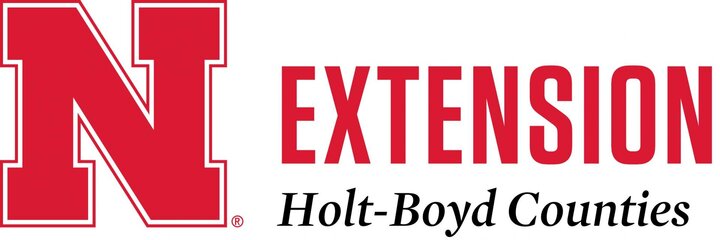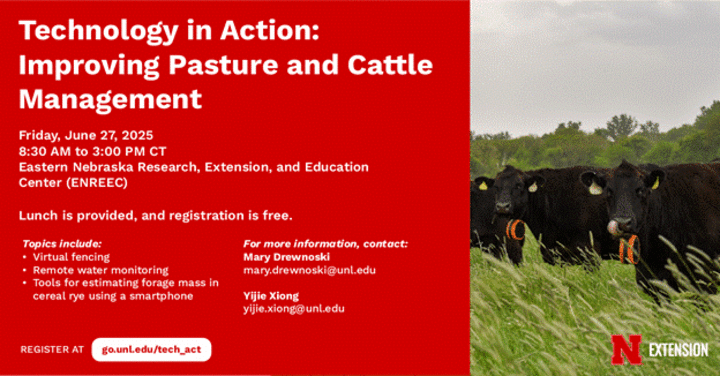
Nebraska Extension Educator - Holt/Boyd Counties - LaDonna Werth
Nebraska Extension Educator - Holt/Boyd Counties - Amy Timmerman
Nebraska Extension Educator - Brown/Rock/Keya Paha Counties - Brittany Spieker
Nebraska Extension Educator - Holt/Boyd/Garfield/Loup/Wheeler Counties - Bethany Johnston
Nebraska 4-H Assistant - Holt/Boyd Counties - Debra Walnofer
June 22-27: 4-H National Shooting Sports National Championships, Heartland Public Shooting Park, Alda, NE
June 23: DUE: President’s Environmental Youth and Educator Awards application, PIAEE@epa.gov
June 26: Boyd County Fair Entries Open and Close on July 10 https://boyd.fairwire.com
June 27: Technology in Action: Improving Pasture and Cattle Management Field Day, Mead, NE
June 28: Holt County 4-H Shooting Sports - .22 Rifle, SB Pistol, Muzzleloader, SG, BB Gun, AR, AP, Archery Practice; Holt County Fairgrounds, Chambers, NE
July 1: DUE: Holt and Boyd County Pre-Fair Day Entries, https://holt.fairwire.com/ or https://boyd.fairwire.com
July 7: Holt County 4-H Shooting Sports - .22 Rifle, SB Pistol, Muzzleloader, SG, BB Gun, AR, AP, Practice + Coach’s Meeting; Holt County Fairgrounds, Chambers, NE
July 10: DUE: Boyd County Fair Entries Close, https://boyd.fairwire.com
July 10: DUE: Boyd County Fair Animal Entries, Static Entries (INCLUDES Shooting Sports)
July 10: DUE: Boyd County YQCA Certificates; Horse Levels Completed and Pen/Stall/Cage Request
July 11: Young Rancher Workshop - Nebraska Grazing Lands Coalition and Ranch Management Consultants - Burwell, Nebraska, Contact Leah Peterson: director@nebraskagrazinglands.org, 308-872-1250
July 15: Holt County Pre-Fair Day, 9am, Solid Rock Youth Center, O’Neill, NE
July 16: Boyd County Pre-Fair Day, St. Mary’s Catholic Church Hall, Spencer, NE
July 17: DUE: Boyd County Bucket Calf, Bottle Lamb, and Bottle Goat Record Books
July 17: Boyd County Fair Set-Up, Spencer, 7:00pm
July 19-20: Boyd County Fair 4-H Shooting Sports Competitions, Gross, NE
July 22: Entry Day for Boyd County Fair Static Entries
July 22-26: Boyd County Fair, Boyd County Fairgrounds, Spencer, NE
Traveling With Children
All of us have heard the familiar phrase “Are we there yet?” from children who are bored from sitting for what they perceive as an endless amount of time in a vehicle, or are so excited about their destination they just can’t wait any longer.
Parents often overlook travel time as an opportunity to interact with their child(ren). What better opportunity to spend some quality time? For most, it is a question of ideas for what to do with their children during drive time. Here are some activities that can be fun for everyone when traveling with children. (Note: These activities should only be done with the adult not responsible for driving.)
- Bubbles: Keep some bubbles in a non-spill container in the car and blow some for baby when someone else is doing the driving. This calms a baby down (and older children will enjoy it too). Tiny bubble containers sold for weddings or party favors are ideal.
- Read a good picture book: Even very young babies will respond to a good book. You don’t have to read the entire story (especially if you yourself are prone to car sickness), simply hearing your voice as you point to pictures in the book will occupy time and keep them entertained.
- Play classical music: Studies have indicated that classical music may boost baby’s intelligence.
- Peek-a-boo: This classic game is perfect for the car
LaDonna Werth
Extension Educator
Phone: 402-336-2760
E-mail: lwerth2@unl.edu

- This Little Piggy: As long as you’re stuck in the car, might as well kick off your shoes!
- Where is your nose: An older baby can practice learning all the parts of the body. Ask them to show you where they are starting with their nose. Then help them find their head, mouth, cheek, ear, chin, hand, foot, tummy, etc.
- Surprise packages: Prepare ahead with paper bags of items to be given out every 25, 50 or 75 miles as marked on a map with the location. It takes a little bit of prep to do this, but it really helps young children. In each bag put a wrapped item, usually a small toy. Then add various other things to each surprise package, like a juice box or a snack, stickers and a piece of paper, or something pertaining to the trip that you can talk about.
- Aluminum foil modeling: Give everyone a sheet of aluminum foil. Have them mold it into anything they want: animal shapes, balls, jewelry, crowns, etc.
- Pipe cleaners: Pack a bag of multi-colored pipe cleaners and let their imaginations run wild!
- Cookie sheet magnet board: Use an old cookie sheet and a collection of ABC magnets. Children can work on putting the letters in order or identify beginning sounds.
- Name the clouds: What do they look like? Find as many different shapes as you can.
- Tell jokes: Take turns telling silly jokes.
Source: Angie Fletcher, Human Development Specialist, Texas County, University of Missouri Extension
Alfalfa Insect Update
As we approach the first cutting for alfalfa across the state of Nebraska, it is important to continue to monitor your fields for pest insect activity.
One of the most significant insect pests of alfalfa in Nebraska is alfalfa weevil. Plant injury from alfalfa weevil feeding damage appears as pinholes in the terminal leaves, with leaves becoming skeletonized as feeding severity increases. Larvae are 1.5 mm to 8.5 mm long with a black head, wrinkled green body, and white stripes along the back and sides and will curl into a C-shape when disturbed. Scouting for alfalfa weevil up to and even during the first cutting can help to mitigate economic losses. While you are actively cutting your alfalfa field, take some time to inspect your equipment for larvae. Threshold tables can be found on CropWatch.
Aphids are another insect pest of alfalfa, and while they are considered a secondary pest, populations sometimes surpass treatment guidelines. Heavily infested plants will be discolored and stunted. There are four species of aphid found in Nebraska alfalfa: pea aphid, cowpea aphid, blue alfalfa aphid, and spotted alfalfa aphid. Descriptions and species-specific thresholds can be found in this article. (https://cropwatch.unl.edu/lookout-alfalfa-weevil-emergence-and-scouting/)
A variety of insecticides are labeled for alfalfa insect pest control, including pyrethroids and products containing indoxacarb (such as Steward). Pyrethroids are more harmful to natural enemies, while indoxacarb is more selective and may help to maintain beneficial
Amy Timmerman
Extension Educator
Phone: 402-336-2760
E-mail: atimmerman2@unl.edu

insect populations. This can be especially important in fields with high aphid populations as they have a wide range of natural enemies including lady beetles, lacewings and syrphid fly larvae. When alfalfa reaches 50% or more bud stage, it may be more profitable to cut the alfalfa early rather than treat it.
Source: Samantha Daniel – Extension Educator (CropWatch – June 5, 2025)
Helping Cattle Cope with Summer Heat
Ready or not, summer heat has arrived. Cattle have had little opportunity to become acclimated to summer conditions this year, so helping cattle cope is critical. The combination of hot temperatures, high humidity, and lack of air movement can cause severe cases of heat stress for cattle. This can result in reduced intakes and gains, and in extreme cases, death.
Cattle do not handle heat stress as well as humans. The range of temperature in which cattle do not use additional energy to maintain core body temperature is referred to as the thermoneutral zone. This zone generally ranges from 32°F to 75°F for cattle but can vary depending on metabolic size. When temperatures exceed the upper critical temperature, cattle expend energy in attempt to dissipate heat. Panting and elevated respiration and heart rate are signs that this is occurring. When temperatures remain above 70°F during the night, cattle are unable to recover before the next episode of heat exposure.
Some heat stress mitigation strategies to consider include:
- First and foremost, providing plenty of water and space around water tanks for each animal. When the temperature is above 80°F, cattle require nearly twice as much water (up to 30 gallons per head per day).
- Sprinklers with a large droplet size can be effective in cooling cattle and pen surfaces in dry conditions; however, limit use when humidity and moisture are high.
Bethany Johnston
Extension Educator
Phone: 402-336-2760
E-mail: bjohnston3@unl.edu

- Removal of excess manure is critical. When manure builds up, it holds moisture and increases humidity.
- Bedding pens is also an option to help lower the temperature of the pen surface.
- Providing shade can help reduce the heat load on cattle up to 20 degrees. Again, providing adequate space per animal is important when using shade structures. Overcrowding will have very little production benefit.
- Avoid working or transporting cattle during extreme temperatures. If necessary, handle cattle early in the mornings and not any time after 10am.
- Consider reducing the amount of feed delivered in the morning to help lower the heat load on cattle, starting the morning before a heat event occurs.
- Improve air flow by incorporating tall mounds and placing cattle in pens with fewer windbreaks in the summer.
- Monitor weather frequently for potential heat events. Keep an eye out for predicted temperatures in the high 80s and 90s, especially following a rain and in situations where the wind speed is going to be less than 5 mph for several days. The Temperature Humidity Index chart, U.S. Meat Animal Research Center Cattle Heat Stress Forecast, and Nebraska Mesonet Cattle Comfort Index can be helpful in determining when cattle are at risk for heat stress.
Being proactive rather than reactive is important for avoiding any train wrecks when it comes to heat stress. For more information, see the Heat Stress Mitigation in Feedlot Cattle webinar or the Feedlot Heat Stress Information and Management Guide.
Source: Erin Laborie, Nebraska Extension Educator (UNL Beef - June 9, 2021)
News Release
More Control, Less Effort: Cattle Technology Field Day Set for June 27 at ENREEC
Producers looking to improve grazing efficiency and reduce labor demands are invited to attend the Technology in Action: Improving Pasture and Cattle Management field day, hosted at the Eastern Nebraska Research, Extension, and Education Center (ENREEC) near Mead, Nebraska on Friday, June 27, 2025 from 8:30AM to 3:00PM CT.
This free, full-day event features hands-on demonstrations and in-depth discussions focused on technologies that help producers get more from their pasture and streamline cattle management. Topics include virtual fencing, remote water monitoring, and tools for estimating forage mass in cereal rye using a smartphone.
Key highlights include:
- See virtual fencing in action with cow/calf pairs and observe how more intensive grazing management improves pasture utilization
- Explore different remote water monitoring systems in the field and compare their real-world performance—battery life, signal coverage, and alert reliability.
- Learn how to use a simple photo-based forage estimator to support stocking decisions and timing of grazing cereal rye and other winter cereals.
Indoor sessions will provide practical details on virtual fencing platform comparisons, pricing structures, and research findings on using VF to manage multiple groups and to strip graze annual forages.
Lunch is provided, and registration is free.
Register at: https://go.unl.edu/tech_act
This event is sponsored by USDA-SARE and organized by Nebraska Extension
For more information, contact:
Mary Drewnoski – mary.drewnoski@unl.edu
Yijie Xiong – yijie.xiong@unl.edu
